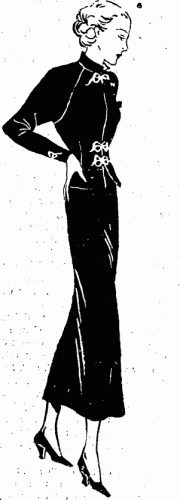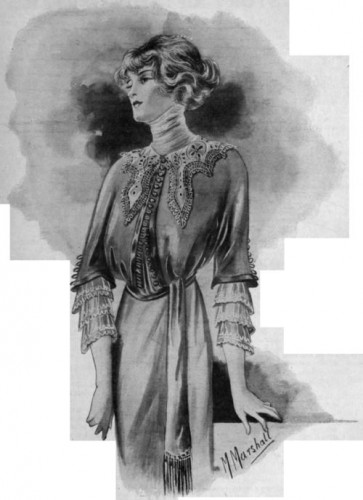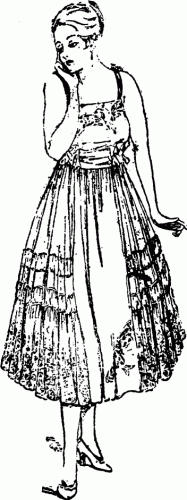Today a corsage is a small bouquet of flowers pinned to your bodice or worn on your wrist, but that hasn’t always been what a corsage is. Corsage used to be a term for a bodice.

"Dress of clear muslin, worn over a slip of clear silk, having the corsage low, and en cœur in front", from Godey's, August 1860
While a small bouquet of flowers and a blouse may seem like very different things, the terms are actually related. Women used to gather a small nosegay of flowers to wear on their bodice, or their gentlemen admirers would send them small bouquets to be worn to an event. These nosegays were called ‘corsages’ (basically a shortening of ‘corsage bouquet’) because they were specifically meant to be worn on a woman’s corsage.

"A corsage by Charvet. It is a blouse of pink cambric finely plaited, and with a white cascade frill, also of cambric, down the center. The scarf is of white cambric and the waistband of pink cambric." From the Chicago Tribune, 1898. Via Wikimedia Commons
In the same way, men would wear flowers in their buttonholes, and these were (and still are, in the UK and a few other places) called ‘buttonholes’ though the name didn’t stick as well in America, and today they are more likely to call them boutonnieres (which is just French for buttonhole).
The term ‘corsage’ comes from the French cors, or body, and thus has the same root as corset. It dates back to the 15th century, but only in the 19th century did it become commonly used as a term for a bodice.
Via chestofbooks.com
In the early 19th century a corsage was predominantly a bodice, but by the end of the century the term was used equally for both uses, so that in 1893 one might read an article describing flower clusters for a corsage and a year later an article describing the latest fashions in corsage bodices, and a few months later read:
Corsage bouquets are boldly treated to be in keeping with the puffed sleeves that rule for the nonce…A dainty corsage decoration for a young lady is composed of two light bunches of lily-of-the-valley, connected by fine sprays of amilax
The term corsage for a fitted bodice was still widely used until the start of WWII, but is rarely seen as a term for a bodice, rather than a cluster of flowers pinned to the bodice, post 1940.

Ensemble of navy jersey, the sleeves in one with the corsage, the collar small & upstanding with a tight waistline & a close-fitting skirt. Bows of white ivory at the neck, on the corsage & sleeves, complete the picture. Evening Post, 30 November 1935
A corsage usually, but not exclusively, referred to a women’s bodice, and usually, but not exclusively, referred to a tight-fitted, structured bodice.



The whole area of meaning-change in language is so interesting – the way, in this case, where that which is worn on the thing, takes the name of the thing itself. It makes it very tricky to read historical articles and descriptions – you think you know what is going on, but you can be so wrong. It is like what a friend of mine calls ‘false friends’ – those words you see in another language, and on whose lexical bosoms you happily fall, crying, ‘I know you!’ And they don’t mean what you think at all.
I did like “A dainty corsage decoration for a young lady is composed of two light bunches of lily-of-the-valley, connected by fine sprays of amilax.” Good grief! The poor girl would look like a house with window boxes and swags! Or an exhibit in the Chelsea Flower Show!
And the ‘ensemble’ (that used to be a much used term) from the Evening Post is most fetching, particularly the jacket, with its raglan sleeves and frogging.
http://blog.inkyfool.com/2012/05/donning-and-doffing.html
One of my favourite language blogs, talking about ‘don’ and ‘doff’. Another for the ‘how language changes’ file!
the-athenaeum.orgI do love ensemble as a term (so much better than ‘outfit’).
I think two small bunches of lily of the valley, with a bit of ‘amilax’ (I suspect they mean smilax) would look very nice across the bodice of a simple 1890s dress for a young lady. They did go in for heavy ornamentation!
Just imagine Catherine Vlasto with flowers instead of those bows 😉
http://www.the-athenaeum.org/art/full.php?ID=8199
I’ve been catching up with your blog after having been away. I read where you were frustrated with gathering large amounts of fabric for skirts, etc. Everyone hates this…the gathering thread breaks, or the gathers “walk” as you stitch over them on the machine. Ugh.
Here is my method that works really well. I hand stitch the rows ofgathering threads using waxed dental floss. The handstitching allows you to precisely space and control the gathers,the floss never breaks, and the slight amount of wax on the floss has a grip that holds the gathered fabric in place. The result is more evenly spaced gathers. I have never had any residue from the waxed floss mess up my fabric. Oh, sure, it is a little more labor intensive, but saves time in the long run. Not to mention sweating and cursing.
In German, a Corsage is a strapless tightly fitted bodice.
And I, too, am very fond of the Ensemble in navy jersey.
Thanks for the tip. Now there will be one less trip up when I read older articles. I will no longer be trying to figure out where the flowers are on the dress!
In my younger years I used to love trashy novels where the woman goes back in time. They rarely looked at the communication problems that would happen between someone speaking older English and someone speaking modern English. And I only found one book that basically had the woman suddenly become illiterate because she could not make head nor tails of the wording and spelling. Films set in another era have the characters speak modern English (with the odd thee and thou thrown in). It might be fun to have them speak as they really would and have subtitles.
I’ve always wondered about those time travel plots! There are always so many trip-ups that they never consider.
And you might get lucky in your desire for a film with accurate language. I’ve heard some rumors 😉
These terminology posts are so useful, this clears up a lot of confusing stuff I have read. Now I won’t be wondering if they put the wrong picture with the article. The english language makes no sense at all, even if it’s your first language.
“Nosegay” is such a fun word, and now I know what it means.
Thank you.
Thank you! And I’m glad I also managed to teach you about two words – one which isn’t even a textile word!
I’ve been reading some society columns from the 1890s that describe dresses as having a “low corsage.” What exactly would that look like? I understand it is the bodice, but does that mean it is low cut or low waisted or the flowers are placed low on the dress? Any thoughts? Thanks!
Hi Catherine, a low-corsage is a low-cut bodice. A dress with a low corsage is one for evening wear.